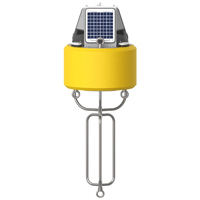 Green Bay has suffered continuous influxes of pollutants and contaminants from the Fox River due to non-point source runoff in the watershed. Deterioration of the bay’s water quality extends well into the last century, and while cleanup efforts in the bay have been successful overall, continuous monitoring of the bay is important to ecosystem management.
Green Bay has suffered continuous influxes of pollutants and contaminants from the Fox River due to non-point source runoff in the watershed. Deterioration of the bay’s water quality extends well into the last century, and while cleanup efforts in the bay have been successful overall, continuous monitoring of the bay is important to ecosystem management.
Researchers at the University of Wisconsin (UW) have been studying the bay for decades and have been actively monitoring it remotely since 2012. More recently, a team of three researchers, Jessie Grow (UW-Milwaukee), Michael Zorn (UW-Green Bay), and J. Val Klump (UW-Milwaukee), deployed NexSens data buoys in the bay to monitor water quality.
Challenge: Green Bay as a Model Mesocosm of Stressors
Green Bay is a model mesocosm of nearly all of the stressors that have disrupted the Great Lakes for more than a century, like excessive algal growth, harmful algal blooms (HABs), decreased water clarity, decreased submerged aquatic vegetation, and hypoxia.
Furthermore, as a result of climate change, climate model predictions show warmer winters, increased precipitation, warmer and more prolonged summers, and a higher frequency of extreme events.
“These changes have the potential to exacerbate an already degraded system, with the potential for ‘dead zones’ and adverse impacts on the biota becoming both more frequent and extensive,” cautions Klump.
 Solution: Remote Hypoxia and Harmful Algal Bloom Monitoring
Solution: Remote Hypoxia and Harmful Algal Bloom Monitoring
The goals of the monitoring program are to (1) monitor hypoxic dead zones in the bottom waters of southern Green Bay and (2) provide real-time data on harmful algal blooms.
In order to meet these goals, the team focused on designing a smaller, lower-cost LoRaWAN buoy that would ultimately allow for more sensors to be deployed and improve the team’s overall understanding of hypoxia and algal bloom dynamics.
Cellcom, a local network services provider, worked with UW to install 7 LoRaWAN gateway receivers on existing cell towers located around the lower bay of Green Bay.
 On the CB-50, a NexSens TS210 temperature string (4 nodes) allows the team to monitor temperature throughout the water column (0.5m, 3m, 4m, and 5m), and a bottom In-Situ RDO Blue dissolved oxygen/temperature sensor combination allows them to record stratification and any periods of hypoxia at the site.
On the CB-50, a NexSens TS210 temperature string (4 nodes) allows the team to monitor temperature throughout the water column (0.5m, 3m, 4m, and 5m), and a bottom In-Situ RDO Blue dissolved oxygen/temperature sensor combination allows them to record stratification and any periods of hypoxia at the site.
The CB-150 is equipped with the same In-Situ dissolved oxygen bottom sensor as well as two optical Yosemitech sensors at the surface, which monitor chlorophyll-a and phycocyanin fluorescence, as well as temperature.
“These combined devices send LoRaWAN data packets out at programmed intervals to Cellcom’s mega/field gateways and then to a network server. After several additional processing steps, the data are subsequently integrated with the Great Lakes Observing System’s (GLOS) Seagull platform,” explains Zorn.
Benefits: Continuous Data Collection in Green Bay
 Buoy size, customizable mooring, sensor compatibility, power efficiency, and future-proof capabilities were at the forefront of considerations for the platforms.
Buoy size, customizable mooring, sensor compatibility, power efficiency, and future-proof capabilities were at the forefront of considerations for the platforms.
Piloted for the first time in 2022, two NexSens buoys (a CB-50 and a CB-150) configured with LoRaWAN technology were deployed in the bay. The following season, in 2023, the systems were refined, and three additional CB-150 buoys were added.
“NexSens buoys provide an easily managed, customizable, and robust platform that is ideal for development of a sensor network that can be efficiently deployed from small watercraft, host solar power supply systems, and are readily available at a reasonable cost,” explains Grow.
The project continued in 2024 and the team plans to expand efforts in 2025. The team plans to test a pilot program to instrument one or more fishing nets using the LoRaWAN network in areas where hypoxia has become a potential problem.
These nets will provide real-time oxygen and temperature data via the GLOS Seagull data platform that could alert fishing operators to potential hypoxic waters hitting their nets, thereby allowing them to respond in a timely manner and minimizing losses.
The Bottom Line
The team anticipates their findings will help make water quality data more accessible to regional shareholders in the bay and improve understanding of short-term conditions and long-term trends. Historical and future data can refine climate models and ecosystem forecasting. Helping improve management in Green Bay.
Equipment
The CB-75 data buoy is a compact, affordable, and easy to deploy platform for both water and atmospheric observations.
The NexSens CB-150 Data Buoy is designed for deployment in lakes, rivers, coastal waters, harbors, estuaries and other freshwater or marine environments.
The NexSens TS210 Thermistor String provides high precision temperature measurements for profiling in lakes, streams, and coastal waters.




